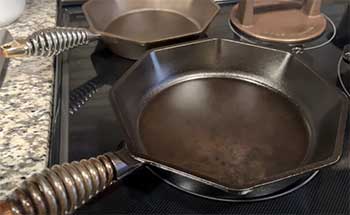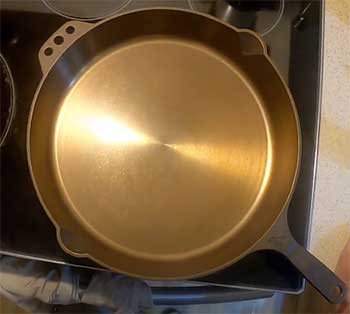Cast iron pans have made a major comeback in recent years, and for good reason. These classic cookware pieces provide unparalleled heat retention and distribution, allowing you to sear, sauté, bake, broil, fry, and more.
Cast iron develops a natural non-stick surface called a patina over time, and if properly cared for, can last for generations.
When shopping for cast iron, two premium brands stand out: Finex and Smithey. But how do you choose between them? Let’s take an in-depth look at the key differences between Finex and Smithey cast iron cookware.
A Brief Comparison Table
| Feature | Finex | Smithey |
| Origin | Portland, Oregon | Charleston, South Carolina |
| Manufacturing Process | Traditional casting | Computerized casting |
| Handle Design | Integrated stainless steel coil | Welded on stainless steel strap |
| Cooking Surface | Pebbled texture, rough | Smooth polished |
| Non-Stick Ability | Develops over time | Excellent out of the box |
| Shape Options | Octagonal skillets, specialty pans | Round skillets, grill pan |
| Weight | Heavier | Lighter |
| Price | $$ | $$$ |
| Warranty | Lifetime | Lifetime |
| Aesthetic | Rustic, stylized | Minimalist, refined |
Overview of Finex and Smithey

Finex is an American company founded in 2012 that handcrafts heirloom quality cast iron pans in their Portland, Oregon factory.
Their cast iron skillets feature an integrated stainless steel coil handle that stays cool while cooking.
Finex uses a traditional casting process and smooths their pans via manual polishing.
Smithey is another American company founded in 2015 that produces cast iron pans in Charleston, South Carolina. Their cast iron skillets also have a stainless steel handle, but it’s welded onto the pan instead of integrated.
Smithey uses advanced computerized machinery for a higher level of precision and consistency. Their pans have a smoother cooking surface right out of the box.
Key Differences Between Finex And Smithey Cast Iron Pans
Both brands offer a range of accessories like lids and press inserts. They come pre-seasoned with a natural wax/oil blend and carry a lifetime warranty. Finex and Smithey are similar in terms of quality and performance, but have a few key differences.
- Design and Aesthetics
The most noticeable difference between Finex and Smithey is the style. Finex pans have a more rugged, traditional look with a coiled handle and exposed rivets. Smithey pans are streamlined and minimalist, with a welded strap handle and no visible rivet heads.

Finex offers their signature octagonal skillets in a variety of sizes, plus grill pans and specialty pieces like oval roasting/paella pans.
Their unique integrated handle is their standout design feature.
Smithey focuses on round skillets in different diameters, plus a grill pan and chicken fryer.
The satin black cooking surface provides an understated elegance. Smithey’s handle is perhaps more ergonomic than Finex’s coiled grip.
It comes down to visual preference – both deliver on quality construction and cooking ability. Finex brings a bit more flash and uniqueness, while Smithey opts for a refined, straightforward look.
- Cooking Surface
One of the biggest differences between these two brands is the cooking surface. Finex uses a traditional cast iron casting process, resulting in a rougher cooking surface with a pebbled texture. Their pans require building up the patina over time.
Smithey employs a computerized casting technique for a smoother surface with tighter precision between pans. Their skillets feel glassy smooth right out of the box, akin to a well-seasoned pan. This provides stick resistance immediately without having to build up the patina first.
So in terms of non-stick ability, Smithey may have an initial edge. However, a well-loved Finex pan will develop that slick patina equally well. It’s about whether you want that natural seasoning process, or prefer the non-stick convenience from day one.
In terms of heat distribution, you can expect excellent performance from both brands. Cast iron’s heat conduction powers depend largely on thickness, and Finex and Smithey are comparably hefty.
- Ease of Use
Thanks to their smooth cooking surface, Smithey pans may have a slight ease of use advantage. Food slides around a little easier during cooking and cleaning. The smoother texture also makes Smithey pans ideal for delicate foods like eggs, fish, and pancakes that can stick to a rougher surface.
On the other hand, some people find the rough pebbled texture of Finex helps provide “bite” for searing meats. This textured surface also seems to assist with oil pooling in a more effective seasoning layer.
In terms of handle comfort, Smithey’s handle may feel a bit more ergonomic and streamlined versus the bulkier coiled grip of Finex. But the integrated design of the Finex handle allows for superior strength and durability. It’s a tradeoff between ergonomics and resilience.
- Price
Finex and Smithey cast iron fall into a similar premium price range, costing $160 to $375 depending on size. Smithey pans tend to run about $25 to $50 more on average per piece.
Here are some representative prices:
- Finex 8″ skillet – $160
- Smithey No. 8 skillet – $175
- Finex 10″ skillet – $185
- Smithey No. 10 skillet – $210
- Finex 12″ skillet – $275
- Smithey No. 12 skillet – $300
The pricing difference can likely be attributed to Smithey’s more automated manufacturing process and smoother cooking surface finish. For the quality, both offer excellent value compared to other high-end cast iron brands.
- Durability

In terms of longevity, Finex and Smithey are equals when properly cared for. The thick cast iron construction allows them to last a lifetime and beyond when maintained. Both carry an identical lifetime warranty covering any defects in materials or craftsmanship.
Some users note the integrated coil handle of Finex pans feels a bit more rugged and indestructible compared to Smithey’s welded strap handle. But Smithey’s handle is still reinforced for strength, not just looks. You can expect either brand to become heirloom pieces if taken care of.
- Seasoning and Maintenance
Seasoning and cleaning cast iron comes down to following proper techniques no matter the brand. Both Finex and Smithey arrive pre-seasoned so they are ready to use out of the box.
However, the smoother Smithey surface means their pans have a bit more seasoning applied initially. Finex pans likely require a little more time and effort to build up the non-stick patina layer, while Smithey pans may have a slight head start.
For cleaning, you’ll want to avoid harsh soaps with either brand. Stick to gentle scraping and scrubbing with water, salt, oil, or non-abrasive tools. Then dry thoroughly and reapply a thin seasoning layer after each use. Proper maintenance is what keeps cast iron in peak form over the decades.
Frequently Asked Questions (FAQ)
No, Finex is not made by Lodge. Finex is its own company that produces cast iron cookware in Portland, Oregon. Their cast iron is branded and designed exclusively by Finex.
Lodge is a popular cast iron producer with foundries in South Pittsburg, Tennessee. While Lodge and Finex are both American companies focused on cast iron, they operate separately.
The key differences come down to design, production process, price point, and overall aesthetic. Finex pans are more labor intensive and have the signature integrated coil handle, while Lodge uses automated molding for more affordable mass production.
Some of the top cast iron pan brands include Lodge, Finex, Smithey, Stargazer, Field Company, Butter Pat, Marquette Castings, and Camp Chef.
There is no consensus on one single “best” cast iron pan brand. All have merits, whether it’s cooking performance, design, price point, smoothness, lightweight properties, or other factors.
Premium brands like Finex, Smithey, Stargazer, and Field Company are excellent for heirloom-quality pieces with smooth cooking surfaces. Lodge and Camp Chef provide great bang for your buck. Ultimately the “best” cast iron pan comes down to individual cooking style and needs.
For the most part, one quality cast iron pan will function similarly to another. Brand is less important than proper use and care when it comes to performance.
However, the brand can make a difference in certain aspects like price, appearance, weight, handle design, pre-seasoning, smoothness, and fit & finish. Minor surface variances between brands typically even out after building up seasoning over time.
While a more expensive premium brand may last a lifetime if properly maintained, a budget pan can potentially cook just as well. So brand is not a dealbreaker unless you have specific needs or preferences. Focus on size, shape, weight, and price point in addition to brand reputation.
Both Smithey and Field Company are modern American brands making heirloom-quality cast iron skillets. But there are a few notable differences:
Price – Field skillets are less expensive at $100 to $200 versus $175 to $300 for Smithey.
Handle – Smithey features a metal handle welded on, while Field uses a contoured cast iron handle.
Surface – Smithey pans come polished extremely smooth, Field has a more rugged hand-finished surface.
Shape – Field skillets have sloped sidewalls, Smithey’s are straight.
Weight – Field pans are lighter due to material optimization and machining.
In terms of performance, both provide excellent heat distribution and retention. Smithey offers slick convenience straight away, while Field improves over time. Ultimately it comes down to budget and individual preferences around handle, walls, seasoning process, aesthetics, etc. Both are great American-made options.
Final Verdict
When it comes to premium cast iron, you can’t go wrong with Finex or Smithey. Both deliver professional-grade performance and construction that makes them a joy to cook with.
Choose Finex for their signature coiled handle and vintage style that develops seasoning over time. Opt for Smithey for a smoother surface and more modern streamlined design. Collector’s may appreciate having both in their kitchen!
Beyond aesthetics, performance is on par between the two brands. Focus on aspects like size, shape, handle comfort, and price point rather than overall quality. And be sure to properly care for either pan, and it will become a lifelong kitchen companion.

